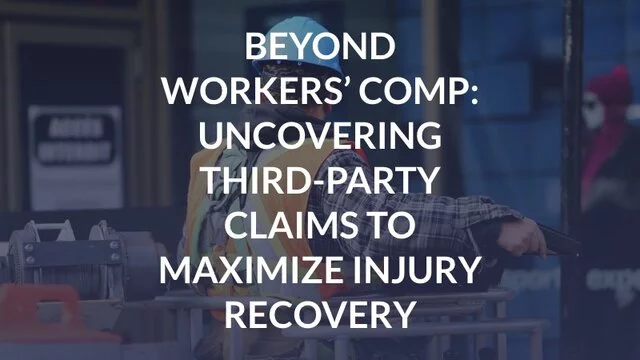
Beyond Workers’ Comp: Uncovering Third-Party Claims to Maximize Injury Recovery
If you’ve been hurt at work, your first instinct may be to file a workers’ compensation claim. While this is the smart thing to do, it may not be your only option.
Many workplace injuries aren’t just the result of bad luck or clumsiness. They’re caused by defective equipment, dangerous work conditions created by outside contractors, or careless drivers who don’t work for your employer. When someone outside your company is responsible, you may have more than just a workers’ compensation claim on your hands, you may also have a personal injury case.
Understanding the difference between a workers’ compensation claim and a personal injury claim, their separate benefits, and how you may be able to file both, could mean the difference between limited benefits and a full financial recovery.
If you have been injured at work, contact Singleton Schreiber today to learn more about your options. Our experienced attorneys will listen to your story and help you determine whether you have a personal injury claim in addition to your workers’ comp claim. Call us today at (619) 771-3473 to schedule a free consultation.

Workers’ Comp 101: What It Covers (And What It Doesn’t)
Workers’ compensation is a no-fault system designed to help injured employees get basic medical treatment and a portion of their lost wages without having to sue their employer. In most states, employers are legally required to carry workers’ compensation insurance as soon as they have one employee. This ensures that injured workers can access benefits and medical care quickly, without lengthy legal battles.
Workers’ compensation covers injuries and illnesses that happen on the job, and offers coverage for the following:
- Medical care and bills
- Temporary disability (a portion of lost wages)
- Permanent disability, in limited and specific cases
- Death benefits
But there are serious limitations. Workers’ comp does not cover:
- Pain and suffering
- Full loss of income or future earnings
- Loss of enjoyment of life
- Many long-term or catastrophic damages
For example, if a warehouse worker falls from a faulty scaffold, workers’ compensation would cover the ER visit and a portion of lost wages. But if the injury leads to chronic pain and a career change due to inability to perform job duties, workers’ compensation wouldn’t fully cover or account for those life-altering consequences. In a situation like this, the worker may choose to file a personal injury claim in addition to their workers’ comp claim in order to pursue full compensation for the broader impact the accident has on their life and livelihood.
Options Available When a Third Party Is at Fault
A “third-party claim” may arise when someone other than your employer or a co-worker causes your injury. These are common in construction, transportation, manufacturing, and many service industries where multiple companies or contractors often work side by side.
Some real-world examples include:
- Defective products – a commercial painter falls and suffers a back injury when a newly purchased ladder (manufactured with a known design flaw), collapses during normal use. The painter may then choose to pursue a third-party claim against the ladder’s manufacturer or distributor.
- Negligence on behalf of other contractors – an electrician working on a construction site trips and breaks their wrist after another subcontractor’s crew from a different company leaves loose tools and cords strewn across a shared walkway. The negligent subcontractor can be held liable in a third-party claim.
- Work-related vehicle crashes – a delivery driver is rear-ended by a distracted driver while on a scheduled delivery route. Because the at-fault driver is not affiliated with the driver’s employer, the injured worker can pursue a personal injury claim against that driver in addition to collecting workers’ comp.
- Unsafe premises – a janitorial employee is assigned to clean a retail store after hours. While working, they slip on a wet floor near a leaking refrigeration unit that the store owner failed to repair or warn about, despite multiple prior complaints. Because the injury occurred due to the property owner’s negligence, not the employer’s, the worker may pursue a third-party premises liability claim.
In situations where you are injured on the job due to a third party’s negligence, you don’t have to choose between filing a workers’ compensation claim and a personal injury claim. You can and should pursue both to maximize the damages you may recover. Workers’ compensation can provide immediate support for medical care and partial income, while a personal injury claim allows you to seek full compensation for long-term losses, like pain and suffering, reduced earning capacity, and loss of quality of life.
How Workers’ Compensation and Personal Injury Claims Can Work Together to Maximize Your Recovery
When a third party is responsible for your injury, workers’ compensation and personal injury claims can be used together to cover both short-term needs and long-term losses.
Workers’ comp is designed to move fast. It typically covers medical treatment and partial wages replacement right away. A personal injury claim takes longer, but offers a more robust compensation for long term impacts like pain and suffering, loss of future income, and reduced quality of life.
To make the most of both compensation options, the claims need to be strategically coordinated. This includes preserving workers’ compensation lien rights and managing credits or offsets to avoid reducing your recovery.
If a workers’ compensation claim pays for your medical bills and lost wages, they can claim reimbursement from your personal injury settlement through a lien. A skilled attorney can often negotiate that lien so that you may keep more of the compensation from your personal injury claim, especially for things workers’ comp doesn’t cover, like pain and suffering.
Additionally, you also need to manage offsets, which are adjustments to avoid overpayment. For instance, if your personal injury case pays out first, your workers’ compensation benefits may be reduced or paused. Planning ahead helps avoid surprises and makes sure that the two cases work together, not against each other.
For example, a worker who falls from a defective scaffold receives $300,000 in workers’ compensation benefits. Later, they secure an $800,000 personal injury settlement against the scaffold manufacturer. The combined recovery of $1.1 million reflects the true, long-term cost of the injury.
Common Traps and Missed Opportunities
Oftentimes, injured workers, and sometimes even lawyers, will fall into the trap of thinking the injury or situation is only applicable for a workers’ compensation claim, causing them to miss out on the chance to pursue a third-party claim. That mindset can cost the worker hundreds of thousands of dollars in potential recovery.
Other common pitfalls include:
- Failing to investigate equipment defects, unsafe jobsite practices, or third-party contractors
- Allowing key evidence, like broken tools or failed machinery, to be discarded before an expert can inspect them
- Letting the workers’ compensation claim settle before identifying and filing the third-party case
- Misunderstanding deadlines. Personal injury claims often have longer statutes of limitations than workers’ compensation claims, but you still need to act quickly to preserve your rights and evidence.
What Injured Workers and Their Lawyers Should Do
If you’re injured on the job, one key question must be asked immediately: was someone outside the company involved?
The answer to that question determines whether you may have a third-party claim, and whether you could recover more compensation than is available through a workers’ comp claim alone.
Steps you should take after suffering a job related injury or illness:
- Launch an early investigation, including site visits and preserving faulty equipment or dangerous conditions.
- Consult with a personal injury lawyer, especially in cases involving serious or life-altering injuries.
- Coordinate with both workers’ compensation and personal injury attorneys to manage liens, offset issues, and settlement timing.
- Keep your options open. Don’t let the workers’ compensation process close the door on full recovery.
Getting hurt at work can be overwhelming. But accepting workers’ compensation as your only option may leave you under compensated and unsupported in the long run. You deserve full, and fair compensation when you’ve been injured on the job due to someone else’s negligence and identifying and pursuing third-party claims can help you achieve that.
If you’ve been injured on the job and someone else may be at fault, don’t settle for less than you deserve. Talk to a lawyer at Singleton Schreiber today who can help you determine whether you have grounds to file both a workers’ compensation and a personal injury claim. Call us at (619) 771-3473 to get started today.
- Founding Partner
Brett Schreiber leads our Personal Injury and Wrongful Death practice group, representing individuals and families who have been harmed by the wrongful conduct of others. He has successfully litigated complex cases involving ...

